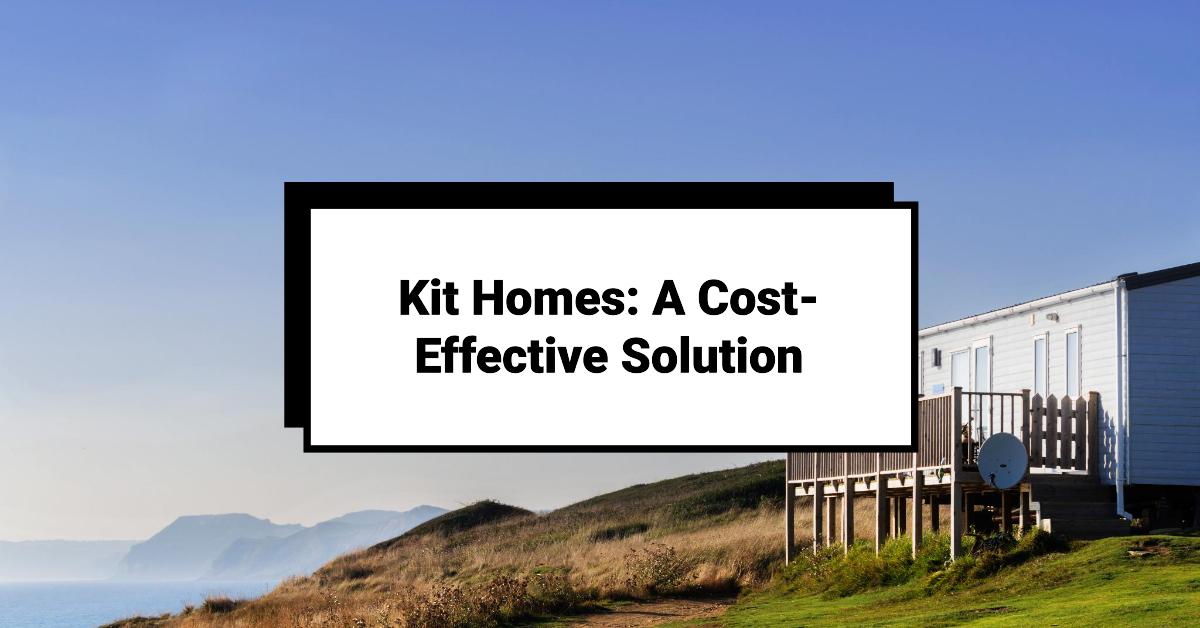Kit homes offer substantial financial benefits, including up to 40% savings on construction and labor costs due to pre-engineered components and reduced construction timelines of 3 to 6 months. Energy-efficient designs can cut energy consumption by up to 30%, leading to lower utility bills. Maintenance costs are reduced by approximately 20% annually, attributed to durable materials and DIY maintenance opportunities. Customizable financing options and enhanced resale value driven by modern, sustainable designs also add to their appeal. For those considering long-term financial efficiency, the advantages of kit homes present a compelling case worth exploring further.
Initial Cost Savings
One of the main financial benefits of kit homes is the significant reduction in initial construction costs compared to traditional building methods. This cost efficiency arises from the streamlined manufacturing process, which allows for bulk purchasing of materials and reduced labor expenses. Data indicates that kit homes can result in savings of up to 20-40% on initial construction expenditures.
Additionally, these savings are bolstered by the long-term savings potential due to the energy-efficient designs inherent in most kit homes. Energy-efficient components and materials can significantly lower utility bills over time, enhancing the overall financial feasibility.
Design flexibility is a key feature that adds to the financial appeal of kit homes. Buyers can customize their homes to meet specific needs and preferences without extensive architectural redesign, reducing both time and cost.
Moreover, kit homes tend to have a lower environmental impact. The precision in manufacturing minimizes waste, and the materials often used are more sustainable, promoting eco-friendly construction practices. Customization options in kit homes often include environmentally conscious designs that can further enhance their value proposition by lowering environmental footprints and operational costs.
Reduced Construction Time
In addition to the initial cost savings, kit homes offer a notable reduction in construction time due to their pre-engineered components and streamlined assembly process. According to industry data, the construction period for traditional homes ranges from 6 to 12 months, whereas kit homes can be assembled and completed in as little as 3 to 6 months. This expedited timeline is largely attributed to the pre-fabricated nature of the components, which are manufactured in a controlled environment and delivered with precise specifications.
The use of eco-friendly materials further enhances the efficiency of the construction process. These materials, often engineered for lightweight and durability, reduce the logistical and labor complexities typically encountered with conventional building supplies. Consequently, the speed of construction can be significantly accelerated.
Moreover, kit homes do not compromise on customization options. Sophisticated designs and modifications can be implemented without extending the construction timeline substantially. Clients can choose from a multitude of floor plans, architectural styles, and finishes to match their personal preferences and functional requirements, without the delays usually associated with bespoke designs.
Lower Labor Expenses
Frequently, the assembly of kit homes significantly reduces labor expenses due to the simplified construction process and the need for fewer skilled tradespeople. Data indicates that traditional home construction typically involves intricate scheduling of various subcontractors, including electricians, plumbers, and carpenters. Conversely, kit homes arrive with pre-cut materials and detailed instructions, allowing homeowners to either undertake the construction themselves or require minimal professional assistance. This DIY potential translates to considerable savings on labor costs, often accounting for up to 20-40% of the total construction expense.
Moreover, the inherent design of kit homes facilitates customization without escalating labor costs. Unlike conventional systems where modifications can be labor-intensive and costly, kit homes offer flexibility in design within the initial package. This adaptability enables homeowners to tailor their residences to personal preferences without incurring additional labor expenditures.
Economically, kit homes encourage sustainability and eco-friendly building practices. The precision manufacturing of components results in less material waste, thereby reducing disposal costs and contributing to a more sustainable building process. While direct financial benefits are evident in lower labor expenses, there are complementary advantages in promoting sustainability, which can appeal to environmentally conscious homebuyers.
This alignment with fiscal efficiency and eco-friendly principles positions kit homes as a compelling alternative in modern construction.
Energy Efficiency
Numerous studies highlight that kit homes tend to exhibit superior energy efficiency compared to traditional homes, resulting in substantial long-term savings on utility costs. This enhanced energy efficiency primarily stems from the precision engineering and high-quality materials often used in kit home construction. For instance, the Thermal Performance of Residential Dwellings report by the U.S. Department of Energy indicates that kit homes can reduce energy consumption by up to 30%. This translates to significant cost savings over the lifespan of the home, especially when considering escalating energy prices.
From an environmental impact perspective, energy-efficient kit homes considerably reduce greenhouse gas emissions. According to a study by the Environmental and Energy Study Institute, buildings contribute nearly 40% of global carbon dioxide emissions.
Hence, selecting a kit home with superior insulation and efficient HVAC systems mitigates this issue by lowering energy demands. Furthermore, many kit homes are designed to integrate renewable energy sources such as solar panels, which not only enhance cost savings but also bolster sustainability efforts.
Financing Options
Given the financial advantages associated with energy efficiency in kit homes, potential homeowners frequently explore various financing options to make their investment more feasible.
In order to optimize the cost-efficiency of their purchase, understanding the breadth of available financial instruments is paramount.
Several loan options can potentially assist in securing a kit home:
- Construction-to-permanent loans: These loans transition from a construction loan to a permanent mortgage once the home is built, streamlining the financing process.
- Personal loans: These can be advantageous for individuals with strong credit scores, offering an alternative to traditional mortgage options but often come with higher interest rates.
- Savings plans: Systematic savings plans, including high-yield savings accounts, enable future homeowners to accumulate necessary funds while earning interest.
Attention must also be given to payment flexibility and interest rates, both of which can significantly impact the total expenditure over the life of the loan. Given Australia’s emphasis on sustainability and innovation, kit homes Australia are becoming an increasingly popular choice, offering substantial financial benefits and reduced construction timelines.
Fixed and adjustable-rate mortgages each offer unique benefits, with the former providing predictable payments and the latter potentially offering lower initial rates. Customizable payment schedules further enhance flexibility, accommodating a range of financial circumstances.
Maintenance Costs
Evaluating the maintenance costs of kit homes reveals significant long-term savings potential compared to traditional homes. Kit homes are often constructed with high-quality, prefabricated materials designed to ensure long-term durability. This durability translates into fewer repairs and consequently, reduced maintenance expenses over the lifespan of the home.
A study by the National Association of Home Builders (NAHB) indicates that prefabricated homes can save up to 20% on maintenance costs annually compared to their traditionally built counterparts.
The cost-effectiveness of kit homes extends further through DIY maintenance opportunities. Often designed with simplicity in mind, these homes allow homeowners to undertake minor repairs and upkeep themselves, thereby avoiding the high labor costs associated with hiring professionals.
According to a survey conducted by HomeAdvisor, homeowners spend an average of $1,200 annually on minor maintenance tasks when they outsource them. Kit home owners, leveraging straightforward design plans and accessible materials, can significantly cut these costs by performing DIY maintenance.
The implementation of durable materials and the opportunity for homeowners to engage in DIY maintenance collectively enhances the cost-effectiveness of kit homes. These savings can consequently be redirected towards long-term investments, adding an additional layer of financial benefits for discerning homeowners.
Resale Value
The resale value of kit homes demonstrates strong market resilience, often matching or exceeding that of traditional homes due to their quality construction and energy-efficient features. Such attributes contribute significantly to their attractiveness in the secondary housing market, ensuring homeowners a worthwhile investment.
Several factors influence the resale value positively:
- Energy Efficiency: Kit homes are frequently outfitted with the latest energy-efficient technologies, resulting in lower operational costs, which is increasingly appealing to eco-conscious buyers.
- Modern Design and Customization: The flexibility in design and home improvements allows kit homes to stay aligned with contemporary market trends, thus attracting a broader range of potential buyers.
- Quality Assurance: Given their precise manufacturing process and adherence to stringent building codes, kit homes often stand up well over time, adding to their overall marketability.
From a data-driven perspective, these elements collectively contribute to sustained or enhanced resale values in comparison to traditional homes. As market trends continue to favor sustainable and customizable living solutions, the demand for kit homes is expected to remain robust. Buyers seeking both initial financial outlay savings and long-term home equity growth find kit homes to be a prudent choice.
Conclusion
While kit homes promise substantial initial cost savings, reduced construction time, and lower labor expenses, the irony lies in the potential trade-offs regarding maintenance costs and resale value. Energy efficiency and attractive financing options add to their allure, yet future homeowners must critically assess long-term financial implications.
Thus, what may initially appear as an economically sound investment requires a thorough, data-driven evaluation to ensure the benefits, including the ease of appliance repairs and maintenance, truly outweigh any hidden costs.


